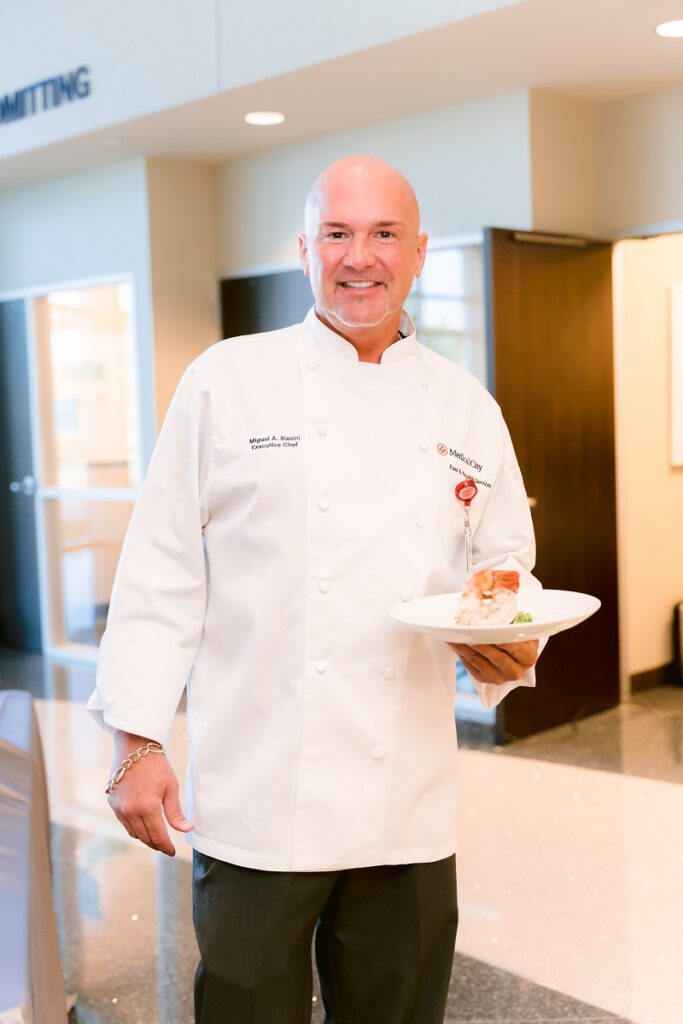Sitting on a sparse chair beside the eight-year-old’s bed, Chef Miguel Blasini was covered in a ubiquitous blue mask, gloves, and gown, trying to connect with the boy who was recuperating from a bone marrow transplant.
Blasini was asked by one of the boy’s physicians to “round the patient,” meaning visit the patient, in this case so he could try to find something that he will eat. The boy had been diagnosed with cancer three years earlier and was struggling. He wasn’t eating and “weight is health to a kid,” the chef tells me.

Chef Blasini, who trained under Wolfgang Puck and worked alongside him when Puck’s group catered the Oscars and Grammy Awards, had a tough customer in this young boy. No milkshakes, macaroni and cheese, or pizza could entice this kid to eat.
Chef decided he’d try one more thing: Wagyu Beef, the deeply marbled, tender beef that comes with its own certificate of provenance that includes a black ink print of the cow’s nose. Turns out, this little guy would eat steak. In fact, he ate enough steak that he gained weight and was eventually discharged from Medical City Children’s Hospital.
Hospital food has long been the butt of many jokes and insults, and even was the subject of a 2018 Eater article titled, “Why is Hospital Food So Disgusting.” Nowadays, that insult is just a cliché, as hospital systems have made quality cuisine for patients and employees a priority. It seems Medical City Healthcare has not only debunked the hospital food stereotype but it’s also elevated its cuisine to craveable status.
In 2008, Medical City’s leadership team made up of the CEO, COO, CMO and various area vice presidents interviewed Chef Blasini and had him prepare a meal using mystery ingredients he was provided, which included bacon, fresh spinach, pecans, sweet potatoes, and others.
The dishes so impressed them that Chef Blasini was hired and given the directive to make Medical City Healthcare’s culinary services best in class. Since dining critics don’t review hospital food, and it’s extremely unlikely that an individual would travel from hospital to hospital just to taste the food, I will assume that they have, at least based on the food I tasted.

Healthy food doesn’t have to taste bad. According to Medical City, under the leadership of Medical City Healthcare Director of Food and Nutrition Services, Mary Ann Moser, RD, a team of executive chefs, including Blasini, and registered dieticians developed new recipes to include more heirloom grains, vegetarian, vegan, and culturally diverse options.
From what I tasted, they knocked it out of the park with meals that are appealing to the eyes, the tongue, the heart, and the stomach. And, with meals that help kids like the eight-year-old Wagyu-loving patient, the soul.

Among the items on the Medical City Heart Hospital’s menu: Shrimp Cocktail; Organic Chicken Roulade filled with spinach, Boursin cheese and vegetables; Avocado and Chili Toast and a colorful, flavorful grilled cauliflower steak served with Romesco Sauce. When I mentioned craveable, this is one of the items to which I was referring. The smokey char of the grill hits the right note with the cauliflower and gets a nice punch from the sauce, which is equal in sweetness, heat, tartness, and richness. This doesn’t sound like hospital food, right?
On the soft/bland diet menu, there is a grilled watermelon salad with orange zest-balsamic syrup, French feta, candy stripe beets, and Thai basil which was also phenomenal.
Soups on this menu include a Lobster-Sherry Bisque and a Wagyu Beef Burger. Dessert includes the ever-present hospital gelatin but also a scratch-made Chipotle Chocolate Cake.
All this healthy, delicious food prepared and served while you’re in the hospital, but what happens when you leave and try to eat healthy at home? Medical City has weekly cooking classes for patients and their families so they can learn how to prepare meals to keep their bodies healthy. The classes are in person and include demonstrations and instruction on why some foods are better for you than others.
Medical City Healthcare and its parent company, HCA, have a motto: Care Like Family. The concept is to care for patients and their families, employees, physicians, staff, and the community at large as if they are your own family. Want the best for them, treat them with compassion, kindness, and care, and provide them with comfort when you can, and for many of us, that’s through food.
There are some patients who simply won’t get to taste this amazing cuisine. As I sat in the vast kitchen of the Heart & Spine Hospital, I saw boxes upon boxes of feeding products for patients on Percutaneous Endoscopic Gastrostomy (PEG) tubes.
As lovely as was my meeting with Chef Blasini, as was the food, the reality hit me: food is a luxury some can’t afford. This isn’t a restaurant, but it is a massive culinary operation, where nurses are the maitre’ds, the servers, and healers all at once. The revamped diets and menus prepared here are meant to keep and make people healthy. It is sustenance defined.
Postscript
Since my visit to Medical City Heart & Spine Hospital, the delta variant of COVID-19 has detonated and hospital staff is once again, besieged, exhausted, inundated.
When I see the photos of nurses, doctors, housekeeping staff, and the myriad people who make medical facilities function, I feel for them and I care for them, like family. I wish I could prepare each and every one of them a good meal, give them rest, tell them it will be over soon, and they can return to normalcy. Thank you all for serving on the front line.
By the Numbers:
4,000 Number of meals Chef Blasini’s team prepares and serves per day
100 Number of staff in Medical City’s culinary team
30 Number of different diets Medical City provides
5 Number of campuses that make up Medical City Dallas
